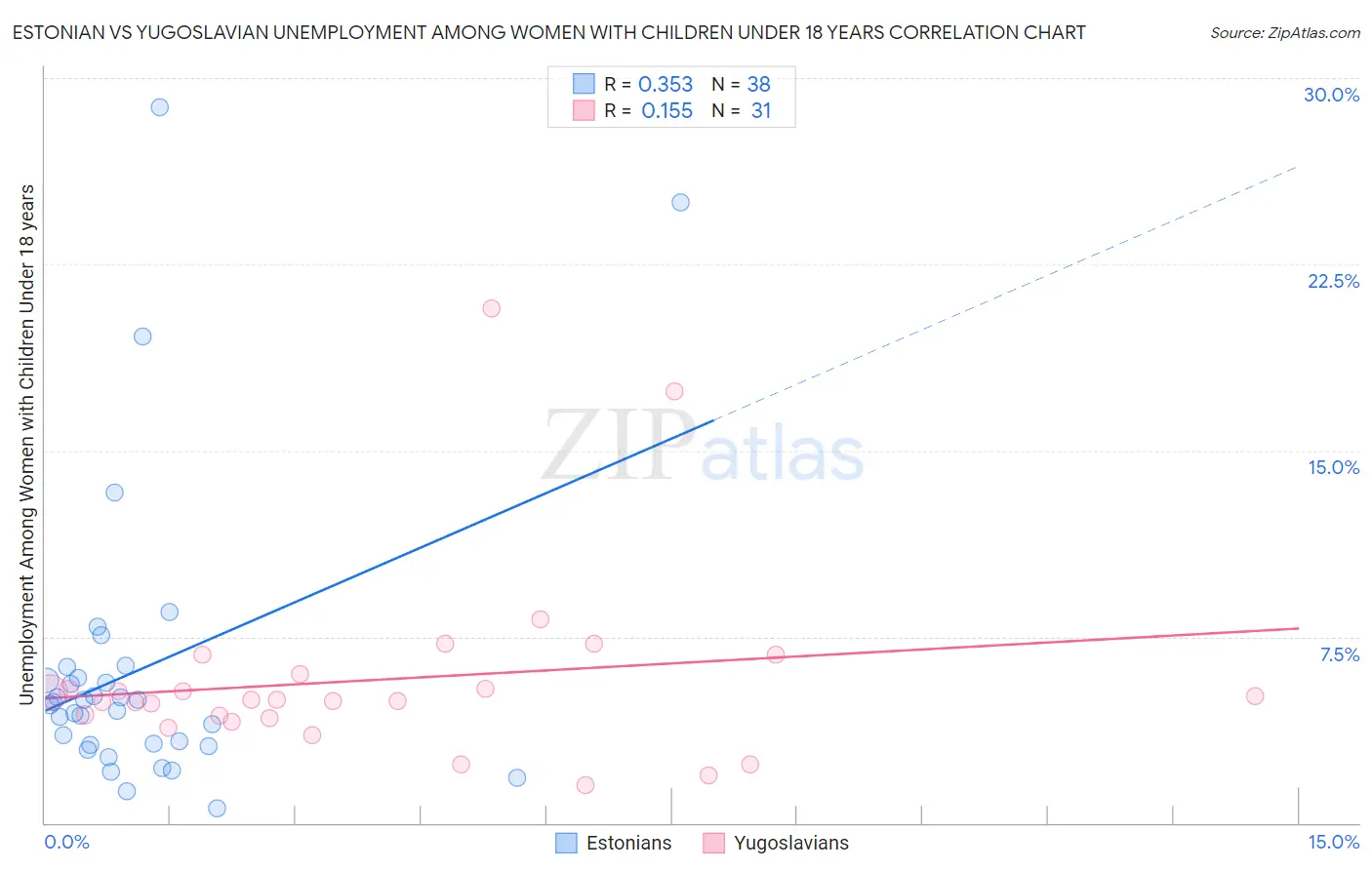Estonian vs Yugoslavian Unemployment Among Women with Children Under 18 years
COMPARE
Estonian
Yugoslavian
Unemployment Among Women with Children Under 18 years
Unemployment Among Women with Children Under 18 years Comparison
Estonians
Yugoslavians
5.1%
UNEMPLOYMENT AMONG WOMEN WITH CHILDREN UNDER 18 YEARS
97.2/ 100
METRIC RATING
64th/ 347
METRIC RANK
5.1%
UNEMPLOYMENT AMONG WOMEN WITH CHILDREN UNDER 18 YEARS
98.3/ 100
METRIC RATING
51st/ 347
METRIC RANK
Estonian vs Yugoslavian Unemployment Among Women with Children Under 18 years Correlation Chart
The statistical analysis conducted on geographies consisting of 121,191,816 people shows a mild positive correlation between the proportion of Estonians and unemployment rate among women with children under the age of 18 in the United States with a correlation coefficient (R) of 0.353 and weighted average of 5.1%. Similarly, the statistical analysis conducted on geographies consisting of 276,335,631 people shows a poor positive correlation between the proportion of Yugoslavians and unemployment rate among women with children under the age of 18 in the United States with a correlation coefficient (R) of 0.155 and weighted average of 5.1%, a difference of 1.0%.

Unemployment Among Women with Children Under 18 years Correlation Summary
| Measurement | Estonian | Yugoslavian |
| Minimum | 0.60% | 1.5% |
| Maximum | 28.8% | 20.7% |
| Range | 28.2% | 19.2% |
| Mean | 6.2% | 5.8% |
| Median | 4.8% | 4.9% |
| Interquartile 25% (IQ1) | 3.2% | 4.2% |
| Interquartile 75% (IQ3) | 5.8% | 6.0% |
| Interquartile Range (IQR) | 2.7% | 1.8% |
| Standard Deviation (Sample) | 6.0% | 3.9% |
| Standard Deviation (Population) | 5.9% | 3.8% |
Demographics Similar to Estonians and Yugoslavians by Unemployment Among Women with Children Under 18 years
In terms of unemployment among women with children under 18 years, the demographic groups most similar to Estonians are Immigrants from Sweden (5.1%, a difference of 0.020%), Immigrants from Australia (5.1%, a difference of 0.12%), Fijian (5.1%, a difference of 0.14%), Italian (5.1%, a difference of 0.17%), and Immigrants from Bulgaria (5.1%, a difference of 0.19%). Similarly, the demographic groups most similar to Yugoslavians are Immigrants from Nepal (5.1%, a difference of 0.0%), Immigrants from Japan (5.0%, a difference of 0.080%), Scottish (5.1%, a difference of 0.090%), Lithuanian (5.0%, a difference of 0.11%), and Immigrants from Serbia (5.1%, a difference of 0.12%).
| Demographics | Rating | Rank | Unemployment Among Women with Children Under 18 years |
| British | 98.7 /100 | #47 | Exceptional 5.0% |
| Northern Europeans | 98.6 /100 | #48 | Exceptional 5.0% |
| Lithuanians | 98.4 /100 | #49 | Exceptional 5.0% |
| Immigrants | Japan | 98.4 /100 | #50 | Exceptional 5.0% |
| Yugoslavians | 98.3 /100 | #51 | Exceptional 5.1% |
| Immigrants | Nepal | 98.3 /100 | #52 | Exceptional 5.1% |
| Scottish | 98.2 /100 | #53 | Exceptional 5.1% |
| Immigrants | Serbia | 98.2 /100 | #54 | Exceptional 5.1% |
| Immigrants | Sri Lanka | 98.1 /100 | #55 | Exceptional 5.1% |
| Immigrants | Ireland | 98.0 /100 | #56 | Exceptional 5.1% |
| Czechoslovakians | 98.0 /100 | #57 | Exceptional 5.1% |
| Immigrants | Belgium | 97.9 /100 | #58 | Exceptional 5.1% |
| Asians | 97.9 /100 | #59 | Exceptional 5.1% |
| Welsh | 97.7 /100 | #60 | Exceptional 5.1% |
| Russians | 97.5 /100 | #61 | Exceptional 5.1% |
| Immigrants | Bulgaria | 97.4 /100 | #62 | Exceptional 5.1% |
| Italians | 97.4 /100 | #63 | Exceptional 5.1% |
| Estonians | 97.2 /100 | #64 | Exceptional 5.1% |
| Immigrants | Sweden | 97.1 /100 | #65 | Exceptional 5.1% |
| Immigrants | Australia | 97.0 /100 | #66 | Exceptional 5.1% |
| Fijians | 96.9 /100 | #67 | Exceptional 5.1% |